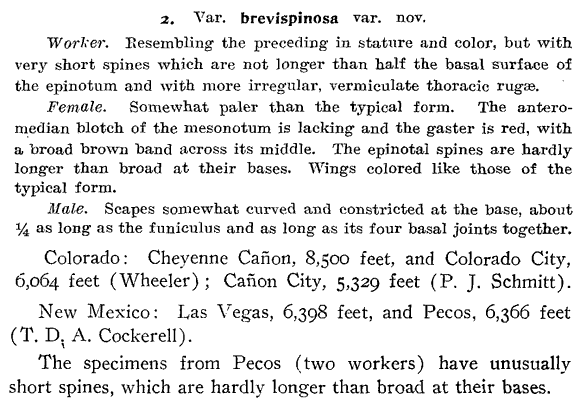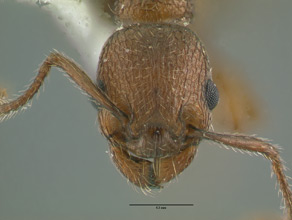- Identification
- Workers in the genus Myrmica are medium sized and have 12 segmented antenna. They show a slightly arched mesosomal profile with no promesonotal suture, a slightly impressed metanotal groove and spines on their propodeum. Coloration varies but is typically drab and dark (e.g., black, dark brown or dark red). Accurate identification of Nearctic Myrmica species is problematic, especially in the western United States. Many named species are difficult to key out and numerous unnamed species are also known to exist (Jansen et al. 2009).
- Myrmica brevispinosa workers are brownish red with a smooth, shiny, dark brown gaster.
- Biology
- Francoeur (2007) makes the clearest statement about what we can glean from the published literature concerning North American Myrmica species: "it is quite difficult to use or interpret published data without voucher specimens." With this in mind we present some information here, from published studies, with the caveat that we presently have a poor understanding of western United States Myrmica forms. Hopefully this serves as a beginning and more observations, tied to vouchered specimens, will be forthcoming about this and other Myrmica species.
- additional biology notes...
- Distribution
- Range
- Canada and United States. Species identification problems in Myrmica make it difficult to delineate the distribution of individual species. In North America the genus ranges from Canada to Central America. Creighton (1950) states the following concerning the distribution of Myrmica brevispinosa: northern New Mexico to southern Alberta, west to Idaho and eastward to Nebraska and North Dakota.
- Navajo Reservation Records
- Samples being processed.
- Additional Notes
- General biology of Nearctic Myrmica species: Small to medium sized colonies, often with more than one queen. Nests can be found in downed wood, under or within objects on the ground, in moss, and in the soil. Most are carnivorous and also tend aphids. They may be found in forests, meadows, bogs, along waterways and in some disturbed habitats. Within their range they are quite common. Southern North America occurrences of Myrmica are primarily confined to mountain habitats as the genus as a whole is adapted to cool, mesic conditions.
- Weber (1950): Myrmica brevispinosa colonies are rather small with nests under stones in grassy banks along streams and in sand on the prairie. Workers were observed near Round Lake, North Dakota tending aphids on dandelion roots. Creighton (1950): Prefers to nest in gravelly stream bottoms and is one of the most thermophilic members of the genus.
- Etymology
- Morphological. Armed with short spines. L. brevis = short + L. spinosus - thorny

- Literature
- Francoeur, A. 2007. The Myrmica punctiventris and M. crassirugis species groups in the Nearctic region. Pages 153-185 in R. R. Snelling, B. L. Fisher, and P. S. Ward, editors. Advances in ant systematics (Hymenoptera: Formicidae): homage to E. O. Wilson - 50 years of contributions. Memoirs of the American Entomological Institute, vol. 80, Gainesville, FL, 690 p.
- Jansen, G., R. Savolainen, and K. Vepsäläinen. 2009. DNA barcoding as a heuristic tool for classifying undescribed Nearctic Myrmica ants (Hymenoptera: Formicidae). 38:527-536.
- Weber, N. A. 1950. A revision of the North American ants of the genus Myrmica Latreille with a synopsis of the Palearctic species. III. Annals of the Entomological Society of America. 43:189-226.
- Wheeler, W. M. 1907. Notes on a new guest-ant, Leptothorax glacialis, and the varieties of Myrmica brevinodis Emery. Bulletin of the Wisconsin Natural History Society. 5:70-83.
- Wheeler, W. M. 1917. The mountain ants of western North America. Proceedings of the American Academy of Arts and Sciences. 52:457-569.
- A note about these publications. The literature cited here is not meant to be an exhaustive list of papers published about this species.
Page authored by David Lubertazzi and Gary Alpert


